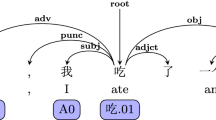Abstract
Mongolian constituent parsing is a challenging task due to lack of hand-annotated corpus and rich morphological varying. This paper takes a self-attention neural network to deal with Mongolian constituent parsing, which follows an encoder-decoder architecture. Concerning the syntactic functions of morphemes in Mongolian words, we make morphological analysis on each word and learn a novel word representation on such basis. To fully utilize the morphological knowledge, we adopt the last suffix tag of each word in the input embedding instead of its POS. The input embedding is the accumulation of word representation, the last suffix tag and the word position. The test experiment demonstrates that our model significantly outperforms the previous Mongolian constituent parsers. We achieve 87.16% F1 on the development set and 86.23% F1 on the test set.
Access this chapter
Tax calculation will be finalised at checkout
Purchases are for personal use only
Similar content being viewed by others
References
Gómez-Rodríguez, C., Vilares, D.: Constituent parsing as sequence labeling (2018)
Wu, R., Mongh, J., Mo, R.: “From-bottom-to-top” to analyze sentence constituent of traditional Mongolian basing on the rule. In: IEEE International Conference on Information & Automation. IEEE (2017)
Arong, **a, Y., Wang, S.: A research on constructing Mongolian Treebank based on phrase structure grammar. In: International Conference on Progress in Informatics & Computing. IEEE (2014)
Arong: The Research of Mongolian Statistical Parsing, Inner Mongolia Normal University, Hohhot (2014)
Wudanmuqier: A Study on Statistical and Rule-Based Combined Mongolian-Chinese Machine Translation. Inner Mongolia Normal University, Hohhot (2017)
**g, N.: A Study on Tree to String Based Mongolian and Chinese Statistical Machine Translation. Inner Mongolia Normal University, Hohhot (2016)
Dyer, C., Kuncoro, A., Ballesteros, M., Smith, N.A.: Recurrent neural network grammars. In: Proceedings of the 2016 Conference of the North American Chapter of the Association for Computational Linguistics, pp. 199–209. Association for Computational Linguistics (2016)
Cross, J., Huang, L.: Span-based constituency parsing with a structure-label system and provably optimal dynamic oracles. In: Proceedings of the 2016 Conference on Empirical Methods in Natural Language Processing, pp. 1–11. Association for Computational Linguistics (2016)
Kitaev, N., Dan, K.: Constituency parsing with a self-attentive encoder (2018)
Gaddy, D., Stern, M., Klein, D.: What’s going on in neural constituency parsers? An analysis (2018)
Hall, D., Durrett, G., Klein, D.: Less grammar, more features. In: Proceedings of the 52nd Annual Meeting of the Association for Computational Linguistics, vol. 1, pp. 228–237 (2014)
Finkel, J.R., Kleeman, A., Manning, C.D.: Efficient, feature-based, conditional random field parsing. In: Proceedings of ACL08: HLT, pp. 959–967. Association for Computational Linguistics, Columbus, Ohio (2008)
Kim, Y., Jernite, Y., Sontag, D., Rush, A.M.: Character-aware neural language models. In: Proceedings of the Thirtieth AAAI Conference on Artificial Intelligence, pp: 2741–2749. AAAI Press (2016)
Coavoux, M., Crabbé, B.: Multilingual lexicalized constituency parsing with wordlevel auxiliary tasks. In: Proceedings of the 15th Conference of the European Chapter of the Association for Computational Linguistics: Volume 2, Short Papers. Association for Computational Linguistics, pp. 331–336 (2017)
Liu, J., Zhang, Y.: Shift-reduce constituent parsing with neural lookahead features. Trans. Assoc. Comput. Linguist. 5, 45–58 (2017)
Wang, W., Bao, F., Gao, G.: Learning morpheme representation for Mongolian named entity recognition. Neural Process. Lett. 2019, 1–18 (2019)
Ling, W., Luís, T., Marujo, L., Astudillo, R.F., Amir, S.: Finding function in form: Compositional character models for open vocabulary word representation. ar**v preprint ar**v:1508.02096 (2015)
Ballesteros, M., Dyer, C., Smith, N.A.: Improved transition-based parsing by modeling characters instead of words with LSTMs. ar**v preprint ar**v:1508.00657 (2015)
Vylomova, E., Cohn, T., He, X., Haffari, G.: Word representation models for morphologically rich languages in neural machine translation (2016)
Vania, C., Lopez, A.: From characters to words to in between: do we capture morphology? (2017)
Shen, D., Wang, G., Wang, W., Min, M.R., Su, Q., Zhang, Y.: Baseline needs more love: on simple word-embedding-based models and associated pooling mechanisms (2018)
Kim, Y.: Convolutional neural networks for sentence classification. In: Proceedings of the 2014 Conference on Empirical Methods in Natural Language Processing (EMNLP), Doha, Qatar, pp. 1746–1751 (2014)
Vaswani, A., Shazeer, N., Parmar, N., Uszkoreit, J., et al.: Attention is all you need. In: Advances in Neural Information Processing Systems 30, NIPS 2017 (2017)
Durrett, G., Klein, D.: Neural CRF parsing. In: Proceedings of the 53rd Annual Meeting of the Association for Computational Linguistics and the 7th International Joint Conference on Natural Language Processing (Volume 1), pp. 302–312 (2015)
Stern, M., Andreas, J., Klein, D.: A minimal span-based neural constituency parser. In: Proceedings of the 55th Annual Meeting of the Association for Computational Linguistics (Volume 1), pp. 818–827 (2017)
Shen, Y., Lin, Z., Jacob, A.P., Sordoni, A., Courville, A., Bengio, Y.: Straight to the tree: constituency parsing with neural syntactic distance (2018)
Liu, N., Su, X., Gao, G., Bao, F.: Mongolian word segmentation based on three character level Seq2Seq models. In: Cheng, L., Leung, A.C.S., Ozawa, S. (eds.) ICONIP 2018. LNCS, vol. 11305, pp. 558–569. Springer, Cham (2018). https://doi.org/10.1007/978-3-030-04221-9_50
Grishman, R., Macleod, C., Sterling, J.: Evaluating parsing strategies using standardized parse files. In: Proceedings of Conference on Applied Natural Language Processing (1992)
Acknowledgments
This work was funded by National Natural Science Foundation of China (Grant No. 61563040, 61773224, 61762069, 61866029), Natural Science Foundation of Inner Mongolia Autonomous Region (Grant No. 2017BS0601, 2016ZD06, 2018MS06025), and research program of science and technology at Universities of Inner Mongolia Autonomous Region (Grant No. NJZY18237).
Author information
Authors and Affiliations
Corresponding author
Editor information
Editors and Affiliations
Rights and permissions
Copyright information
© 2019 Springer Nature Switzerland AG
About this paper
Cite this paper
Liu, N., Su, X., Gao, G., Bao, F., Lu, M. (2019). Morphological Knowledge Guided Mongolian Constituent Parsing. In: Gedeon, T., Wong, K., Lee, M. (eds) Neural Information Processing. ICONIP 2019. Lecture Notes in Computer Science(), vol 11955. Springer, Cham. https://doi.org/10.1007/978-3-030-36718-3_31
Download citation
DOI: https://doi.org/10.1007/978-3-030-36718-3_31
Published:
Publisher Name: Springer, Cham
Print ISBN: 978-3-030-36717-6
Online ISBN: 978-3-030-36718-3
eBook Packages: Computer ScienceComputer Science (R0)




